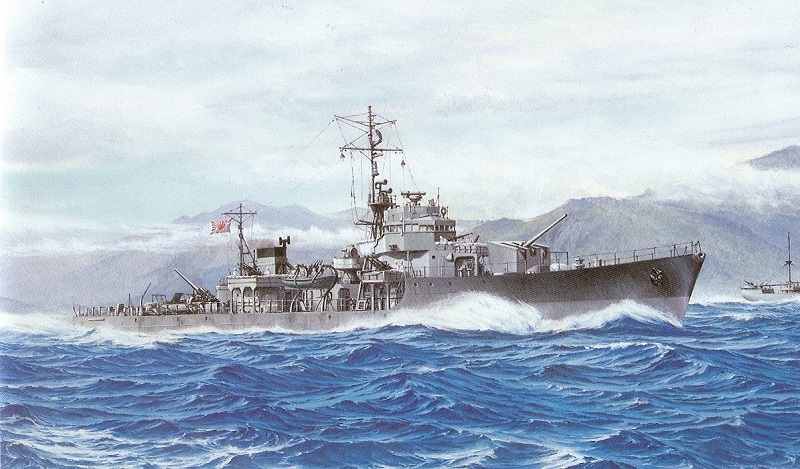© 2006-2017 Bob Hackett, Sander Kingsepp and Peter Cundall
Revision 3
8 September 1944:
Tokyo. Laid down at the Uraga Dock Co. Ltd’s yard as kaibokan No. 5253.
5 October 1944:
Named CHIKUBU. Provisionally attached to Sasebo Naval District.
24 November 1944:
Launched.
10 December 1944:
LtCdr (reserve) Matsushima Takuo (former CO of W-24) is appointed the Chief Equipping Officer.
31 December 1944:
Completed and registered in the Sasebo Naval
District. Assigned to Kure Guard Unit. LtCdr (reserve) Matsushima Takuo is the CO.
26 February 1945:
Assigned to the General Escort Command's First Escort Fleet.
27 February 1945:
Departs Sasebo.
28 February 1945:
Arrives at Kure. Undergoes repairs.
2 March 1945:
At 0700 departs Kure and at 1750 arrives at Moji.
12 March 1945:
At 1900 departs Moji.
15 March 1945:
At 0900 arrives back at Moji.
16 March 1945:
At 0600 departs Moji and at 0700 arrives at Mutsure. At 0900, CHIKUBU departs Mutsure for Keelung with
kaibokan CD-40, CD-102 and CD-106 escorting convoy MOTA-43. The convoy consists
of transports KIYOKAWA, HAKOZAKI, TATSUHARU and NIKKO MARUs.
17 March 1945:
At 1642 the convoy anchores off Hikin To (Pigum Do).
18 March 1945:
At 0554 departs Hikin To.
19 March 1945:
225 miles NNE of Shanghai. At 0258, at 33-07N,
122-05E, LtCdr Robert K. Worthington's (USNA ’38) USS BALAO (SS-285) attacks the convoy and
torpedoes TATSUHARU and HAKOZAKI MARUs. Another torpedo just misses CD-40. HAKOZAKI MARU is torn apart by internal explosions as her cargo of gasoline, shells and torpedoes ignites and blows off her stern. She quickly sinks, but her forward section stays afloat blazing until finally sinking at
0320. The combination of fire, explosions and 5 degree centigrade water means that almost all aboard perish. 928 passengers, 51 gunners and 139 crew, a total
of 1,118 are KIA.
The torpedo strike on TATSUHARU MARU kills 149 military personnel, but
the ship remains afloat and later makes Shanghai. CHIKUBU and CD-102 launch an
unsuccessful depth charge counter-attack on USS BALAO, then rescue 130 survivors. Meanwhile at 1933 CD-106 arrives at Ssu Chiao Shan escorting NIKKO and KIYOKAWA MARUs.
21 March 1945:
At 0800 the other escorts arrives at Ssu Chiao Shan.
22 March 1945:
At 0300 departs Ssu Chiao Shan.
23 March 1945:
At 1825 arrives at Mazu Shan and departs later that day.
24 March 1945:
At 1603 arrives at Fuyan Tao.
25 March 1945:
At 1600 departs Fuyan Tao.
26 March 1945:
At 1700 arrives at Kirun.
1 April 1945:
At 0615, CHIKUBU departs Keelung for Moji with kaibokan
CD-40, CD-102 and CD-106 escorting convoy TAMO-53 consisting of the survivors of
convoy MOTA-43, NIKKO and KIYOKAWA MARUs. Both merchant ships are loaded with
sugar needed for conversion to aviation fuel and butane and evacuees from
Formosa, mostly women and children.
9 April 1945:
Yellow Sea. LtCdr (later MOH/Captain) George L. Street
III’s (USNA ’37) USS TIRANTE (SS-420), alerted by an “Ultra” signal based on code-breaker’s
intelligence, stalks convoy TAMO-53 enroute from Shanghai to Japan. Street fires
three Mark 18-2 electric torpedoes at each of two targets at 36-50N,123-55E. One
spread misses, but the other hits NIKKO MARU in the bow and engine room. She
sinks taking down 563 passengers, 14 gunners, 16 guard force soldiers, two
signalers and 73 crewmen.
The convoy’s escorts counter-attack USS TIRANTE. Street fires a Mark-27
"Cutie" acoustic homing torpedo at CD-102. USS TIRANTE’s crew hears "breaking-up
noises," but the kaibokan does not sink. CD-102 loses seven men blown off the
fantail when the Cutie hits. CHIKUBU tows the damaged kaibokan to safety and rescues
some of the NIKKO MARU's survivors. The remainder of the convoy heads for Moji.
12 April 1945:
CHIKUBU and CD-102 arrive at Pusan, S Korea.
26 April 1945:
Reassigned to the 22nd Coast Defense Group.
5 July 1945:
At 1710 part of the 22nd Coast Defence Group consisting of DAITO, CHIKUBU, CD-8 and CD-52 led by training cruiser KASHIMA arrive at Maizuru.
22 July 1945:
At 1900 training cruiser KASHIMA and kaibokans CHIKUBU, UKURU and TAKANE depart Maizuru. Later CHIKUBU and UKURU are detached.
30 November 1945:
Removed from the Navy List.
1 December 1945:
Assigned to minesweeping duties by the Allied
Occupation Powers.
7 October 1946:
Reassigned as a minesweeper tender.
1 November 1947:
Discarded by the Allies.
26 December 1947:
Transferred to the Japanese Marine Transportation
Bureau’s Central Meteorological Observatory as a weather survey ship. Renamed
CHIKUBU MARU. Participates in summer season typhoon patrols with former kaibokan SHINNAN, IKUNA and UKURU.
1 January 1949:
Transferred to the Japanese Maritime Safety Agency as
a patrol ship. Renamed ATSUMI.
4 October 1962:
Discarded.
Authors' Note:
Thanks for assistance go to Dr. Higuchi Tatsuhiro of Japan, Mr Jeff Donahoo of Iowa and Matthew Jones of Ohio, USA and Mr Gilbert Casse of France.
-Bob Hackett, Sander Kingsepp and Peter Cundall.
Back to
Escort Page



